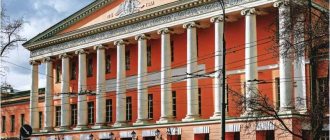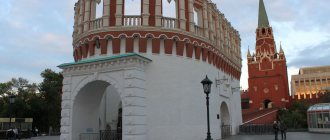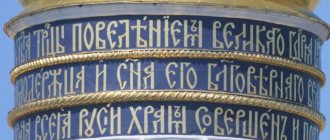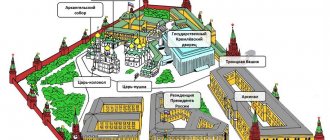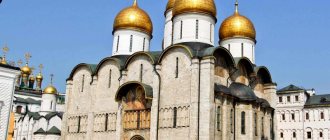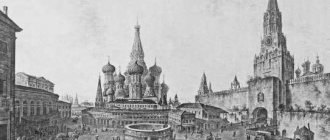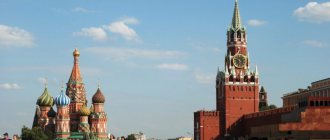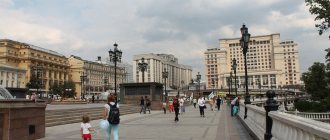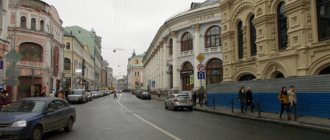The Tsar Bell is one of the iconic Russian landmarks, it is located on the territory of the Kremlin in Moscow. A characteristic detail of the impressive bell is a separate piece of it, which broke off as a result of the efforts to extinguish the devastating Trinity Fire.
Nowadays, the Tsar Bell is a monument that gives an idea of the level of masters of Russian foundry art of the 18th century; it can be seen by anyone who purchases a ticket to visit the architectural ensemble of Cathedral Square of the Moscow Kremlin. Along with the Tsar Bell, tourists can see another outstanding monument - the Tsar Cannon, made in the second half of the 16th century, it is considered the largest cannon in the world.
Tsar Bell on Google Panorama:
The history of the creation of the Tsar Bell
The Tsar Bell, which can be seen in Moscow today, is not the first. It turns out there was an earlier version of it. It was cast in 1600 and weighed approximately 40 tons. Unfortunately, in the middle of the 17th century it crashed. Immediately after this sad event, they decided to smelt a new bell, much larger than the previous one. The weight of the new bell was 130 tons, which was installed next to the bell tower of Tsar Ivan the Great. But he was not destined to “live.” The exact date of his fall is known - it was 1654, Christmas. The bell was damaged during the Christmas bell ringing. But they decided not to stop there either. Turning to professional foundry worker A. Grigoriev, the master was ordered an even larger bell - already weighing 160 tons.
However, it was not destined to ring for a long time - the Grigorievsky bell was broken during a severe fire that happened in 1701. And only 30 years later, Empress Anna Ioanovna decided to make another attempt to revive the Tsar Bell. The duration of preparatory work was 4 years.
To cast a new bell on Ivanovskaya Square, a special mold was created in a pit 10 meters deep. The walls of the form were reinforced with bricks and special oak inserts, and an iron grating was placed on the bottom. Oak piles were used as the foundation of this structure. Next, a bell shape was placed in the pit, into which the metal melted in four smelting furnaces was poured. The casting material was used from the remains of the old Tsar Bell, which was broken during a fire. The project was “officially” led and performed by Ivan Motorin. From this moment on, the chronology of the creation of the Tsar Bell is as follows: the preparatory work was completely completed in November 1734. On November 26, a service was held in the Assumption Cathedral, immediately after which the smelting furnaces were flooded.
And now, it would seem, nothing should prevent the casting of a new bell. However, unexpected things happened again. Two furnaces malfunctioned, molten copper began to flow out and it all ended in a big fire. And after some time, Ivan Motorin died...
They decided not to abandon the work they had started, and Ivan Motorin’s son Mikhail took up the next attempt to create the Tsar Bell. 1 hour and 12 minutes is the exact time it took to cast the final version of the Tsar Bell. The exact date of its creation is also known - November 25, 1735. After casting, the bell began to be decorated with chasing. However, fate intervened here too. In May 1737, another fire started in Moscow. As a result, wooden logs and boards, which served as a frame for the casing in the casting pit, caught fire. The Tsar Bell began to heat up and to prevent it from melting again, it was decided to fill it with water. Naturally, the metal could not withstand such a temperature difference, and a piece broke off from the Tsar Bell. The weight of this piece was 11.5 tons. The most interesting thing is that after the fire no one pulled him out of the foundry pit. And the Tsar Bell lay there for a long time - almost 100 years.
And only during the restoration of the Kremlin after the war with Napoleon, in 1836, the Tsar Bell was erected on a special pedestal. This is how you can see him now
. Installed near the bell tower of Tsar Ivan the Great, this is truly a masterpiece of the foundry art of Tsarist Russia.
The history of the creation of the last Tsar Bell, which is now accessible to tourists, is inextricably linked with another remarkable person - Augustus Montferrand. August Montferrand gained fame as a great specialist in working with heavy structures weighing several tens of tons after the construction of St. Isaac's Cathedral. By the way, he was its chief architect. It was he who helped organize the raising of the Tsar Bell to its pedestal. By the way, the pedestal itself was also designed by Augustus Montferrand. People of that time were literally stunned when they saw the power and beauty of the raised Tsar Bell! The ornamental decorations were especially well done; this was noted in the newspapers of that time.
The same Augustus Montferrand cast a copper orb with a cross installed at the top of the Tsar Bell. The cross is not gold, as many people think, but just gilded. Nevertheless, this does not make the view of the Tsar Bell any less breathtaking. On the bas-reliefs decorating the Tsar Bell, you can see Tsar Alexei Mikhailovich, under whom the previous copy was created, and Empress Anna Ioannovna, the inspiration for the creation of this copy.
After all, it was thanks to her decree that work began on casting a new copper bell. Immediately below the image of Empress Anna Ioanovna there is an inscription informing about the creators of the Tsar Bell - father and son Motorins. They also did not forget about the Christian saints - on the Tsar Bell there are images of Christ with the Mother of God, the Apostle Peter and John the Baptist. However, the fire that happened in 1737 once again prevented the plan from being completed. It is for this reason that traces of unfinished minting are visible on the Tsar Bell. By the way, another master did the chasing. Only recently was his name established - Fedor Medvedev.
Who cast the monument
Initially, they wanted to entrust the casting of the bell to a master from Paris, but he refused, taking this offer as a joke. This position was filled by compatriot Ivan Motorin, who began work in 1730. He was given another master, 10 students and 2 officers to help him.
Also, people from different construction specialties helped to carry out the work: carpenters, masons, joiners, mechanics, blacksmiths. Auxiliary workers carried water, bricks, lime and mixed clay. In total, there were about 190 people involved in the creation of the monument. Sculptors and carvers were busy casting parts and the monument.
To renew the smelting furnaces destroyed during the first smelting, Motorin ordered new materials for existing consumables. These included a huge amount of red brick. It was used for finishing the stove, for lining, strengthening and foundation. This time, precautionary measures were taken to prevent a fire.
The Legend of the Tsar Bell
There is an incredible legend about the Tsar Bell. According to it, the bell was cast during the time of Peter I (late 17th – early 18th centuries). With the return of the Tsar to Moscow after the Battle of Poltava, all the bells rang in honor of the victory. Only one bell did not ring, despite the efforts of the bell ringers to shake up the bell language. In anger, Peter I sent a company of soldiers to help, but they only tore off his tongue, and the Tsar Bell never rang.
People said that the bell is more stubborn than the king. In his hands Peter held the club taken from the Swedish king. Furious that the bell did not want to announce the victory, the king hit it with a club. A piece broke off from the blow, and the Tsar Bell itself went into the ground with a roar. Old Believers and sectarians believe that on the day of the Last Judgment the Tsar Bell will rise and begin to ring.
Preparatory stage
At the beginning of his work, Motorin created a small sample (weighing 12 pounds) as an example, according to which the drawings were made. The created project with drawings was sent to St. Petersburg for approval. The preparation process and waiting for approval took 2 years.
To cast historical heritage, several types of metals were used: a mixture of new metals and an alloy of metal from the Great Assumption Bell, which split during a fire in the Kremlin in 1701. This type of work with metals is called foundry. Hot metal is poured into a certain mold, wait for it to cool, and a product is obtained. The bell was made using this technology.
The use of metals required precise calculations. It was necessary to immerse a certain amount of metal in the furnaces during the second casting. Upon completion of the analysis, the laboratory determined which metal and in what quantity was used to create the cast monument.
The product contains the following metals:
| Metal | Content percentage |
| Copper | 84,51% |
| Tin | 13,21% |
| Sulfur | 1,25% |
| Gold | 0,036% |
| Silver | 0,25% |
Interesting facts about the Tsar Bell:
- In 1941, the bell housed the communications center of the Kremlin regiment. To prevent the giant from shining and being visible to German bombers, it was specially painted;
- Several times conversations began about soldering the bell to use it for its intended purpose. But experts assure that it will not be possible to obtain clear sound;
- 72 kg of gold and 525 kg of silver were added to the melt. This was supposed to improve the sound;
- The Tsar Bell never had a tongue. The tongue next to it was taken from another bell.
Attraction rating
Rating 4.30 [99 vote(s)]
| ← MONUMENTS OF THE KREMLIN | MOSCOW KREMLIN → |
Features of visiting and cost
In order to see the attraction, you need to purchase a ticket to visit the territory of the Moscow Kremlin. It can be purchased at the box office of the Kremlin museums located in the Alexander Garden, in the terminal of the cash pavilion, and on the official website of the Kremlin museums.
The cost of tickets allowing you to get acquainted with the architectural ensemble of the Kremlin’s Cathedral Square:
- full — 700 rub.
- preferential (for full-time students and pensioners) - 500 rubles.
For an additional fee of 300 rubles. You can rent an audio guide.
Children under 16 years old visit the territory for free.
Before visiting, we recommend that you check the current prices on the official website of the Moscow Kremlin museums.
Operating hours of the architectural ensemble:
- from May 15 to September 30 from 9:00 to 17:00
- from October 1 to May 14 from 9:30 to 16:30.
Images and inscriptions on the bell, © Maria Penina
In its place
Finally, in 1836, it was decided to raise the Tsar Bell from the pit and install it on a special pedestal in the Kremlin. The task was entrusted to the French architect Auguste Montferrand , who erected the Alexander Column in St. Petersburg and rebuilt St. Isaac's Cathedral.
On August 17, 1836, the most difficult operation to raise the Tsar Bell was completed. The giant was installed on a pedestal designed by Montferrand.
From that very moment, the bell, which never rang, became one of the main Russian attractions that the whole world knows about.
ADDITIONAL INFORMATION: ADDRESS. TELEPHONE. HOW TO GET THERE
Address: Moscow Kremlin
The Tsar Bell in the Kremlin is the best example of Russian foundry art of the 18th century. Its dimensions are amazing: height – more than 6 meters, diameter at the base – almost 7 meters, weight – 202 tons. This powerful giant symbolizes the power and strength of the Russian state. Among the attractions of Moscow, the Tsar Bell occupies a leading place: not a single tourist will pass by and resist the desire to take a memorable photo against its background.
The current Tsar Bell in Moscow has many predecessors. Starting from the time of Tsar Ivan III Vasilyevich, every ruler considered it his duty to give the order for the creation of a giant bell. The very first, cast in 1462, now seems very modest in size and weight - only 8 tons.
Archangel Cathedral Cathedral Square of the Kremlin
Another famous cathedral on Cathedral Square is the Cathedral of St. Michael the Archangel in the Kremlin, also known as the Archangel Cathedral. The building that has survived to this day was built in 1508 on the site of a dilapidated temple built by Ivan Kalita. The cathedral is famous for its necropolis. In total, there are 54 burials in the necropolis of the Archangel Cathedral, including the shrines of the saints Tsarevich Dmitry Ivanovich, the youngest son of Ivan the Terrible and Mikhail of Chernigov.
